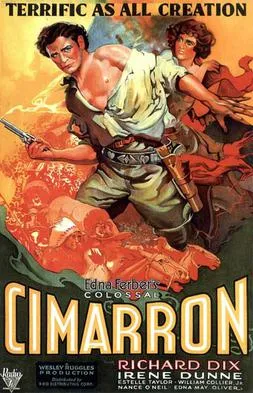
Cimarron is a Western film based on the 1930 novel of the same name by Edna Ferber. There are two film adaptations of the novel: the first was released in 1931 and directed by Wesley Ruggles, while the second was released in 1960 and directed by Anthony Mann and Charles Walters.
The 1931 version won three Academy Awards, including Best Picture, Best Adapted Screenplay, and Best Production Design. The 1960 version starred Glenn Ford and Maria Schell and was not as successful as the original.
While the 1931 version was critically acclaimed at the time of its release, it has since been criticized for its racist overtones and scattershot storytelling.
Plot
The plot of Cimarron revolves around the Cravat family's struggle for survival in the early days of the Oklahoma Territory. The story follows Yancey and Sabra Cravat as they claim a plot of free land and build a life for themselves and their family.
The film depicts their experiences as they face the challenges of frontier life, including the growth of their town into a bustling city by the late 1920s. The movie is known for its epic portrayal of pioneering life and the rapid development of the American West during the late 19th and early 20th centuries.
Trailer
Cast
- Richard Dix as Yancey Cravat
- Irene Dunne as Sabra Cravat
- Estelle Taylor as Dixie Lee
- Nance O'Neil as Felice Venable
- William Collier Jr. as The Kid
- Roscoe Ates
- George E. Stone
- Stanley Fields
Director: Wesley Ruggles
Writer: Howard Estabrook
Box office Gross: $185,642,815
Distributor: RKO Radio Pictures
Genre: Western
Release Date (Theaters): Feb 9, 1931
Release Date (Streaming): Jan 8, 2017
Themes & reception
The themes of Cimarron (1931) include the pioneering spirit, the struggle for survival in the American West, and the rapid development of the Oklahoma Territory. The film was well-received at the time of its release and won three Academy Awards, including Best Picture, Best Adapted Screenplay, and Best Production Design.
However, the film has since been criticized for its racist overtones and scattershot storytelling. Despite this, Cimarron is considered an important film in the Western genre and is credited with helping to establish the popularity of Westerns in Hollywood.
Challenges Faced
During the production of Cimarron, the film faced several challenges. The high production cost, which was then staggering at $1.5 million, was a significant obstacle. This was a considerable sum at the time, especially considering the film was in production only three years after the introduction of talking pictures.
Additionally, the film was released during one of the bleakest times of the Great Depression, which impacted its financial success.
The film's impressive production, including the opening Land Rush scene and the fluid camerawork, was noted as a testament to its quality despite the financial difficulties.
Visual Styles & Techniques
The visual style and techniques of Cimarron (1931) were notable for the time. The film's production, including the opening Land Rush scene and the fluid camera work, was impressive and ahead of its time. The camera work was described as fluid and natural, capturing all the action, which was remarkable for early sound pictures.
Setting
The setting of Cimarron (1931) is the Oklahoma Territory during the Land Rush of 1889. The movie is a sprawling melodramatic epic centered around the great Land Rush of 1889 and its aftermath, and it establishes the fictional town of Osage, using the famous studio's "cowboy ranch" location as its setting. The film portrays the nation rising to greatness through the work of men and women and the territories becoming rich states.
Trivia
- The film was the first Western to win a Best Picture Oscar.
- The celebrated land rush sequence took a week to film, using 5,000 extras, 28 cameramen, six still photographers, and 27 camera assistants.
- The scene is so iconic that, three decades later, when MGM remade the film, the camera angles for the land rush sequence remained almost identical to the original.
- Cimarron has the lowest IMDb rating (5.9) of all Best Picture Oscar winners as of March 2021, along with "Cavalcade" (1933).
- The character Yancey Cravat, played by Richard Dix, was portrayed as a heroic figure, embodying the pioneering spirit of the American West.
Fun Fact
A fun fact about Cimarron (1931) is that it was one of the early Western films that received enthusiastic reception, contributing to the enduring popularity of the Western genre in Hollywood.